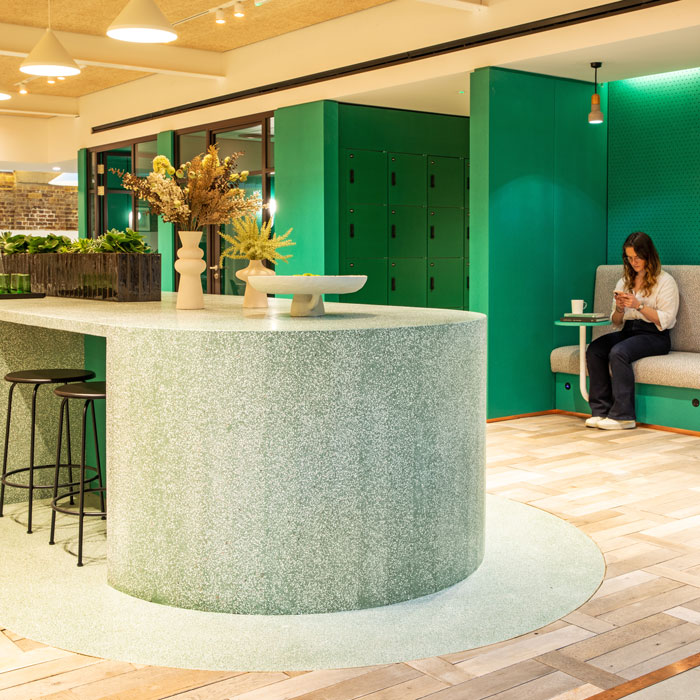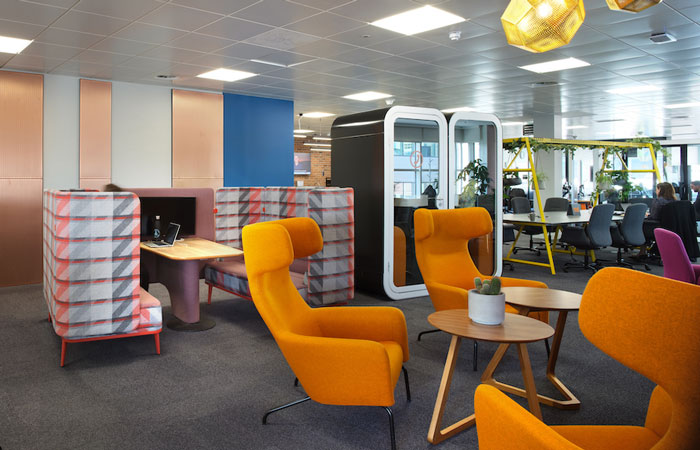A Lifecycle Approach – The Key to Innovative Sustainability
There is an imperative and urgent need to focus on sustainability. It’s increasingly recognised that we can’t continue with current practices without severe consequences to our own health and that of the planet. We need to adopt a more innovative approach throughout the lifecycle of a fit-out project – beginning right at the start through to the demolition phase and into subsequent ‘lives’.
The CEO of FIS, the not-for-profit representative body for the £10 billion finishes and interiors sector in the UK, Iain McIlwee, highlights the issues:
“There remain unacceptably high levels of waste in the fit-out process. It is estimated that 300 tonnes of fit-out waste hits landfill every day!” he explains. “The barriers to better waste management and a more circular approach to products are well rehearsed – complicated logistics, cost of sensitive removal to allow re-use, products not designed to be de-constructed, challenges in warranting products for re-use, a lack of standardisation in sizing and space allowances etc. But, in wake of waste levels this high, the truth is that these excuses are becoming increasingly thin.”
“There is a growing realisation and sustainability is moving rapidly up the priority list, but to really make a difference we need to look at the biggest blocker – time.”

CEO of FIS, Iain McIlwee
“The mantra for transformation in construction is faster, greener, better – the reality is that you can’t have all three at once,” Iain continues. “The Fit-out sector is FAST, at times too fast! We need to allow time for better planning and process control as well as looking at how we develop relationships that can exist beyond individual projects. We can then plan together, exchange information more effectively and support a more responsible approach to the built environment. This means better design, construction and building management. At some point we have to consider the ultimate cost of all of this carbon – by saving a few quid now, we are building up big problems in the future.”
“Our recent research with the University of Reading explores some of these timelines. The reality is that 60% of fit-out work mobilises in less than three weeks and tendering can involve tens of companies. We need to be real about the impact of procurement, often designed to get the lowest price, not the best value. Aggressive tendering practices, combined with rapid mobilisation expectation that is the norm in the fit-out sector, may on the surface appear to offer the client cost advantages, but the reality is that they can be hugely inefficient for the supply chain, eat up time that could be better invested and fundamentally undermine what they can deliver. It may not even be about more time, just shifting our priorities and looking at how we buy as well as mobilise jobs.”

Basha-Franklin, 25 Hanover Square. Basha-Franklin recent commenced disassembly. This is a future forward next generation scheme, reinventing this old stock building. The existing facade is being dismantled, the Portland stone stored and reworked to be used for flooring and aggregate within the new interior scheme.
Nicola Osborn, Creative Director at design studio, Basha-Franklin, is adamant about the necessity for change and focusing on future use right at the start of a project. “Consideration for end of life is needed at the beginning. Clients must buy in to the approach and appreciate that a design programme needs to be longer. Time is needed to really ‘deep dive’ into new approaches and materials.”

Basha-Franklin, 25 Hanover Square
“First and foremost, we review the base building or current interior space to assess and inventory the existing raw material source. What condition are the materials in, how could these be reinvented for new uses and re-purposed elsewhere?” continues Nicola. “Our ethos is focussed on disassemble, responsible removal and reinvent. This process is multiplex, much like sustainability, and requires all stakeholders on the project to be transparent and proactive.”
“Lessons we are learning from our own refurbishment projects of past fit-outs are that the assembly of all new fixtures and fittings, materials, sealants and treatment specification are key to any future end of life and new life strategies. Rigour around supply chain and asking deeper questions regarding manufacturing and processes that produce the materials we use is essential.”

Basha-Franklin, Related Argent. Basha-Franklin successfully reinvented/repurposed the existing timber floor and reinstalled all new floor finishes with magnets to allow ease of relocation, redistribution and re-use at end of life. Also all sealants and adhesives were sustainable and all joinery was mechanically fixed to meet disassembly for end of life strategies.
Senior interior designer and sustainability champion at multi-disciplinary practice, BDP, Emily King explains a more measured approach to fit-out. “We will always start by establishing scope and objectives – what are the needs and requirements? Following this process, we can develop solutions based on minimal changes to achieve maximum impact.”
“Our refresh programmes, for example, are based on a ‘light touch’ with a goal of achieving 95% reuse, particularly furniture. This may include a repaint and reconfiguration whilst avoiding unnecessary changes, such as removal of partitions.”

On PwC’s current refresh workplace projects, BDP are working with the existing furniture and making minimal adjustments to the partitions, but use new key items of furniture, fittings and wall finishes, to lift the space – ’small changes, for big impact’.
“Timelines and budgets do, however, remain significant hurdles,” continues Emily. “Condition audits of existing assets, installation instructions and supervision together with demolition drawings should be the norm. Similarly, more sustainable product solutions often require longer lead times and can be a more expensive initial purchase price.”

BDP, PWC
Ultimately, all members of the project team, including the client, have critical roles in contributing to future sustainability. The message is clear – there is an absolute need for a thorough assessment about the future reuse potential and, therefore, avoidance of waste at the demolition phase.
“We need to look at a more standardised norm here,” says FIS’ Iain McIlwee. “Fundamentally I believe this evolution is a huge opportunity for fit-out contractors to get involved far earlier in the design and planning stage to co-ordinate what we now call strip-out activities as “pre-fit-out activities” and ensure that there is an effective discourse around transitions, assets that can be reused and products that should be designed to be re-used. Again, standardisation is key here and we are this summer releasing a standardised pre-fit-out audit process that helps to ensure assessment and strip-out it is effectively programmed in and not lost in the rush.”
“Information management is also key – the Golden Thread is much talked about in construction, but the Green Thread is just as important. If we have good asset information this can be reviewed at the start of the job, what is re-usable on this job, what can be salvaged for others. This is information that should be available at the start of the whole process, information stored in building passports with full maintenance and inspection reports – circular thinking will deliver circular results.”
What are the future ‘game changers’ from a designer’s perspective?

Basha-Franklin, Related Argent
“Legislation,” asserts Nicola. “We all know this is the right thing to do, unfortunately until there is industry legislation it is still a choice, and many are creating their own directive. The Netherlands has legislative requirements for material repurposing that is driving the fast development of sustainable industry to support climate objectives. Initiatives such as ‘urban mining’ have been in place for decades and this has tax incentives. This would be a game changer for strategising a project, decision making and stock availability would be greater.”

Basha-Franklin, Related Argent
“We definitely need more accessible reuse forums and inventories,” agrees Emily. “Many companies are now introducing ‘take back’ but it’s still difficult to identify suitable products for reuse within a project’s timescales.”
There is now significant evidence of impact of climate change. The interiors sector needs a new cultural narrative – we need to work collaboratively and transparently to support change.




